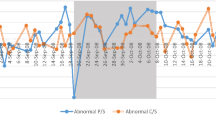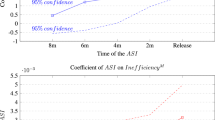Abstract
Prior research argues that pessimistic traders can use options as substitutes for short sales particularly when stocks are expensive to short. Motivated by this contention, we examine the relation between put-call ratios, short-selling activity, and constraints to short selling. Results show that (1) put-call ratios are inversely related, instead of directly related, to proxies for short-sale constraints and (2) the significant negative relation between current put-call ratios and future returns (Pan and Poteshman in Rev Financ Stud 19:871–908, 2006) is orthogonal to proxies for short-sale constraints. These results indicate that short-sale constraints do not influence bearish option activity. While prior studies show that short sellers are generally contrarian in contemporaneous and past returns, we find that put-call ratios follow periods of negative returns. However, any observed return predictability contained in put-call ratios is driven by ratios that follow periods of positive returns.
Similar content being viewed by others
Notes
Bodie et al. (2009) argue that during periods of down markets, investors are likely underhedged and therefore investors will attempt to purchase more put options to protect their long positions.
We note that not all option trading activity should be considered informative trading. Blau et al. (2014) show that the ratio of call option volume relative to put-option volume is directly related to characteristics of the underlying stock that resemble lotteries. These results suggest that some option activity might reflect investors’ preferences for lottery-like distributions. We follow Pan and Poteshman (2006) in order to isolate what might be considered informed option trading activity.
Bloomberg data contains volume for both call and put options across all strike prices and across all expirations.
We also examine the short ratio which is defined as the percentage of trading volume that is made up from short volume, which is commonly used in prior studies. Our results are qualitatively similar. In each of our regression specifications, we control for some form of trading activity so we prefer to result the short-turnover results for brevity.
We report CRSP raw returns in the paper. However, in unreported result we examine two types of market-adjusted returns. EW_adj_ret are CRSP raw returns less the equally weighted CRSP index return while VW_adj_ret are the CRSP raw returns less the value-weighted CRSP index return. The results using these alternative returns produce findings that are qualitatively similar to those reported in this paper.
An examination of hedging activity during bull and bear markets might be a fruitful area for future research. However, these tests are beyond the scope of this paper. See Bodie et al. (2009), p. 742, for example.
We also sort stocks by the other proxies of short-sale constraints and the results are generally similar with the exception of turnover sorts, which produce mixed results. The institutional ownership proxy is given a heavier weight based on arguments in D’Avolio (2002), Asquith et al. (2005), Nagel (2005), and Xu (2007).
Recent theory in Bakshi et al. (2010) suggesting that short selling can affect option prices. Here, we are examining both short selling and option activity on the prices of underlying securities instead of the prices on the options. While outside the scope of this study, perhaps a fruitful area for future research might be to examine the effect of short selling on option returns.
Similar results are obtained when using pooled OLS while controlling for conditional heteroskedasticity and clustering in the error terms.
References
Aitken, M. J., Frino, A., McCorry, M. S., & Swan, P. L. (1998). Short sales are almost instantaneously bad news: Evidence from the Australian Stock Exchange. Journal of Finance, 53, 2205–2223.
Asquith, P., Pathak, P. A., & Ritter, J. R. (2005). Short interest, institutional ownership, and stock returns. Journal of Financial Economics, 78, 243–277.
Avramov, D., Chordia, T., & Goyal, A. (2006). The impact of trades on daily volatility. Review of Financial Studies, 19, 1,241–1,277.
Bakshi, G., Madan, D., & Panayotov, G. (2010). Returns of claims on the upside and the viability of U-shaped pricing kernals. Journal of Financial Economics, 97, 130–154.
Black, F. (1975). Fact and fantasy in the use of options. Financial Analyst Journal, 31(36–41), 61–72.
Blau, B. M., Boone, B. T., & Whitby, R. J. (2014). Gambling preferences, options markets, and volatility. Journal of Financial and Quantitative Analysis.
Bodie, Z., Kane, A., & Marcus, A. J. (2009). Investments. New York: McGraw-Hill Irwin.
Boehmer, E., Jones, C. M., & Zhang, X. (2008). Which shorts are informed? Journal of Finance, 63, 491–527.
Campbell, J. Y., Grossman, S. J., & Wang, J. (1993). Trading volume and serial correlation in stock returns. Quarterly Journal of Economics, 108, 905–939.
Christophe, S. E., Ferri, M. G., & Hsieh, J. (2010). Informed trading before analyst downgrades: Evidence from short sellers. Journal of Financial Economics, 95, 85–106.
D’Avolio, G. (2002). The market for borrowing stock. Journal of Financial Economics, 66, 271–306.
Danielsen, B. R., & Sorescu, S. M. (2001). Why do option introductions depress stock prices? A study of diminishing short sale constraints. Journal of Financial and Quantitative Analysis, 36, 451–484.
Dechow, P. M., Hutton, A. P., Meulbroek, L., & Sloan, R. G. (2001). Short-sellers, fundamental analysis, and stock returns. Journal of Financial Economics, 61, 77–106.
Desai, H., Ramesh, K., Ramu Thiagarajan, S., & Balachandran, B. V. (2002). An investigation of the information role of short interest in the NASDAQ market. Journal of Finance, 52, 2263–2287.
Diamond, D. W., & Verrecchia, R. E. (1987). Constraints on short selling and asset price adjustment to private information. Journal of Financial Economics, 18, 277–312.
Diether, K. B., Lee, K.-H., & Werner, I. M. (2009). Short-selling strategies and return predictability. Review of Financial Studies, 22, 575–607.
Easley, D., O’Hara, M., & Srinivas, P. (1998). Option volume and stock prices: Evidence on where informed traders trade. Journal of Finance, 53, 431–465.
Edwards, A. K., & Hanley, K. W. (2009). Short selling in initial public offerings. Journal of Financial Economics, 98, 21–39.
Engelberg, J. E., Reed, A. V., & Ringgenberg, M. C. (2010). How are shorts informed? Short sellers, news, and information processing, Working Paper.
Evans, R. B., Geczy, C. C., Musto, D. K., & Reed, A. V. (2009). Failure is an option: Impediments to short selling and options prices. Review of Financial Studies, 22, 1,955–1,980.
Figlewski, S., & Webb, G. P. (1993). Options, short sales, and market completeness. Journal of Finance, 48, 761–777.
Mayhew, S., Sarin, A., & Shastri, K. (1995). The allocation of informed trading across related markets: An analysis of the impact of changes in equity-option margin requirements. Journal of Finance, 50, 1635–1653.
Nagel, S. (2005). Short sales, institutional investors and the cross-section of stock returns. Journal of Financial Economics, 78, 277–309.
Pan, J., & Poteshman, A. M. (2006). The information in option volume for future stock prices. Review of Financial Studies, 19, 871–908.
Senchack, A. J., & Starks, L. T. (1993). Short sale restrictions and market reaction to short-interest announcements. Journal of Financial and Quantitative Analysis, 28, 177–194.
White, H. (1980). A heteroscedasticity-consistent covariance matrix estimator and a direct test for heteroscedasticity. Econometrica, 48, 817–838.
Xu, J. (2007). Price convexity and skewness. Journal of Finance, 62, 2521–2552.
Author information
Authors and Affiliations
Corresponding author
Rights and permissions
About this article
Cite this article
Blau, B.M., Brough, T.J. Are put-call ratios a substitute for short sales?. Rev Deriv Res 18, 51–73 (2015). https://doi.org/10.1007/s11147-014-9102-3
Published:
Issue Date:
DOI: https://doi.org/10.1007/s11147-014-9102-3




